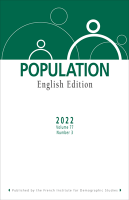
Population 2022, n 3
2022
Estimating Excess Deaths in French and Spanish Regions During the First COVID -19 Wave with the Later/Earlier Method
Ainhoa-Elena Leger, Silvia Rizzi
Ready for a First Birth? Couple-Level Gender Dynamics in the Employment–Parenthood Link in France
Leen Marynissen
From Union Formation to First Birth: The Role of Age at First Cohabitation in the Transition to Motherhood and Fatherhood
Marie-Caroline Compans, Éva Beaujouan
The Population Seen from Space: When Satellite Images Come to the Rescue of the Census
Edith Darin, Mathias Kuépié, Hervé Bass inga, Gianluca Boo, Andrew J. Tatem
Estimating Excess Deaths in French and Spanish Regions During the First COVID -19 Wave with the Later/Earlier Method
Ainhoa-Elena Leger, Silvia Rizzi
Estimates of excess deaths have been widely used to measure the overall impact of the COVID-19 pandemic on mortality. We investigate the validity of a method—the later/earlier method— developed for forecasting the number of deaths one would expect if no shock occurred. We apply this method to estimate excess mortality during the first COVID-19 wave in France and Spain (February–June 2020), stratified by age, sex, and region. Although both countries recorded similar numbers of COVID-19 deaths, Spain had higher excess mortality. The results are informative about differences in COVID-19 vulnerability for population subgroups and spatial areas: adults aged 75–85 were the hardest hit; Île-de-France (Paris region) in France and Comunidad de Madrid in Spain had the highest excess mortality. Applicable to other demographic phenomena, the later/
earlier method is simple, requires fewer assumptions than other forecasting methods, and is less biased and more accurate than the 5-year-average method.
Ready for a First Birth? Couple-Level Gender Dynamics in the Employment–Parenthood Link in France
Leen Marynissen
Research suggests that couples’ labour market preconditions to parenthood have become less traditionally gendered, but couple-level gender dynamics in the transition to parenthood remain understudied. Using detailed longitudinal microdata from the French Permanent Demographic Sample (EDP) and discrete-time hazard models, I examine the potentially gendered and age-specific link between partners’ employment status and relative income and the transition to parenthood in France. The results show significant age-specific associations between partners’ combined employment status and relative income and the transition to parenthood. Overall, first-birth hazards are highest among dual-breadwinner and equal-earner couples. In male and female breadwinner couples, the probability of a first birth is almost equal, but equal and male main-earner couples have their first child earlier than female main-earner couples. These findings suggest that while gender disparities in the employment–parenthood link have diminished in France, gendered associations between partners’ income and first-time parenthood persist.
From Union Formation to First Birth: The Role of Age at First Cohabitation in the Transition to Motherhood and Fatherhood
Marie-Caroline Compans, Éva Beaujouan
Entering a union and having a first child are closely linked events, but social features which may be reflected in the age at union formation, are rarely discussed. Using data from the Étude des parcours individuels et conjugaux, or the EPIC survey (INED–INSEE, 2013–2014), this article examines the role of age at first cohabitation on the occurrence of a first birth and its timing, taking account of the characteristics of individuals and of unions formed between ages 17 and 40. Both men and women have a child more quickly if the union is formed after age 32. While births occur more quickly, permanent childlessness is more frequent among people who form the latest unions, close to the end of their reproductive life, than among those who enter a union at an earlier age. These results remain significant after controlling for employment status at the time of union formation, partnership status, and the partners’ characteristics. In addition to biological aspects, people who form a first union in their 30s may be less inclined to have children or may feel it is socially too late to start a family.
The Population Seen from Space: When Satellite Images Come to the Rescue of the Census
Edith Darin, Mathias Kuépié, Hervé Bass inga, Gianluca Boo, Andrew J. Tatem
The size of the population, the denominator of many statistical indicators, is crucial for public policy. National statistical offices organize the collection of this information, most often through a census. But what happens when parts of a country are not accessible to census enumerators? Today, spatial data extracted from satellite imagery offer high-resolution geographical information with complete coverage. When combined with a
partial population count, they offer an unprecedented opportunity to estimate the size of the population in inaccessible areas. The spatial precision of these data also makes possible the production of a high-resolution gridded population estimate, an innovative data format at the intersection of geography and demography. Based on the case of Burkina Faso, this article analyses how, by dividing a country into 100 m by 100 m cells, a Bayesian hierarchical model can be used to estimate the population of areas with security challenges which could not be enumerated during the 2019 census. This gridding allows the resulting counts to be disaggregated using a statistical learning model, yielding unparalleled spatial precision in population estimates.

